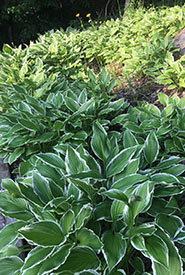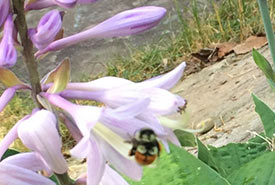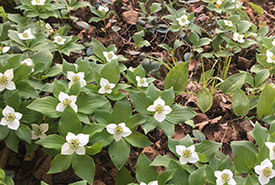Why I'm getting rid of my hostas

Hostas at my cottage (Photo by Dan Kraus/NCC staff)
I love going to the cottage. We have a little cabin nestled between a hill and a lake near Algonquin Park, in the heart of Ontario’s cottage country. There are so many things I love about this place. Water, moose and amazing autumn colours. But there is one thing I don’t love about our cottage: hostas. I’m trying to kill them.
Even if you’re not a botanist or a gardener, you can probably identify a hosta. This is because they are planted everywhere. Originally from Asia, hundreds of hosta varieties have been developed. They are easy to grow and shade tolerant, and for that reason this perennial is often planted in places that don’t get direct sunlight, like wooded areas around cabins.
The lovely couple that owned this cabin before us were avid gardeners. Despite my best efforts to neglect these gardens, many of their plants still persist. I’ve managed to contain the periwinkle and pull all the goutweed that spread to the nearby forest where garden waste was dumped. But the vast beds of hostas haunt me.

Hosta with bumble bee on its flower (Photo by Dan Kraus/NCC staff)
Hostas do have nice flowers, and bumble bees visit them. But there are lots of native plants in these woods with nice flowers that bumble bees visit. Why would someone, decades ago, haul plants and dirt hundreds of kilometres to the doorstep of Algonquin Park, and plant the same flowers you can see on almost any residential street in Canada?
I think there is a good answer to this. An answer to why people will lug plants to their cottage, why people flock to garden centres in the spring, and why people will spend $200 on their vegetable garden for a $20 harvest.
It’s because we all have a deep and ancient connection to plants.
For almost every human generation before ours, a little botanical knowledge was a matter of life and death. We were directly connected to the plants that fed us, the plants that healed us, and the plants that could kill us. As hunters and gatherers, it was critical to distinguish between the palatable and the poisonous. Early humans who failed at plant identification either starved or were poisoned, and removed from our collective gene pool. Our founding farmers also needed to identify the plants that would either help or hinder their crops, or they too would perish.
In the past, it was critical that we be able to identify plants. It was a dangerous and uncertain world if you couldn’t. Somewhere deep in our brain we are perhaps uncomfortable when the botanical setting is unfamiliar.
If there is a deep human need for botanical familiarity, it makes total sense that we surround ourselves with the species that we know. Why would someone plant hostas at the cottage? Because they are familiar. Because in a world where we are increasingly disconnected from other species, we still need to satisfy our primordial need for botanical familiarity.
Our connection to plants is surely as old as humanity. We need to keep it. But we also need to redirect it. A gentle nudge so that we can use that ancient affinity to connect people to nature.

Bunchberry at my cottage (Photo by Dan Kraus/NCC staff)
Our native flora shape and define our great Canadian landscapes. People come from around the world to experience these natural places. At our cabin, the hostas are now being removed and nature is filling those spaces with red trillium, Canada mayflower and trailing arbutus. Visit this place and you will be invited to chew on a wintergreen leaf and mark the season by the colour of bunchberry. Species that define this place. Species that define Canada.
This is what haunts me more than my hostas: there is a global floristic franchise that is replacing our local knowledge and connection to native plants. This creates problems for nature. Purple loosestrife, giant hogweed and Japanese knotweed are among the dozens of invasive plants that originated from our gardens and have now invaded natural areas around the world. Perhaps of greatest concern is that we are missing the opportunity to connect to our own Canadian plants. Everywhere, there are hundreds of native plants, each with its own story. If Canadians don’t learn and share their stories, who will?
Start small. Start now. Discover just a few of the native plants that share your home place. You can learn by using apps such as iNatutalist or by participating in the Nature Conservancy of Canada’s Small Acts of Conservation challenge. Share what you learn, especially with kids.
There is a great revealing of Canadian botanical richness and beauty that awaits us all. There is an urgency in their conservation that starts with awareness and appreciation that can blossom into a love of nature.
A little botanical knowledge is a powerful thing. It could change the world.


